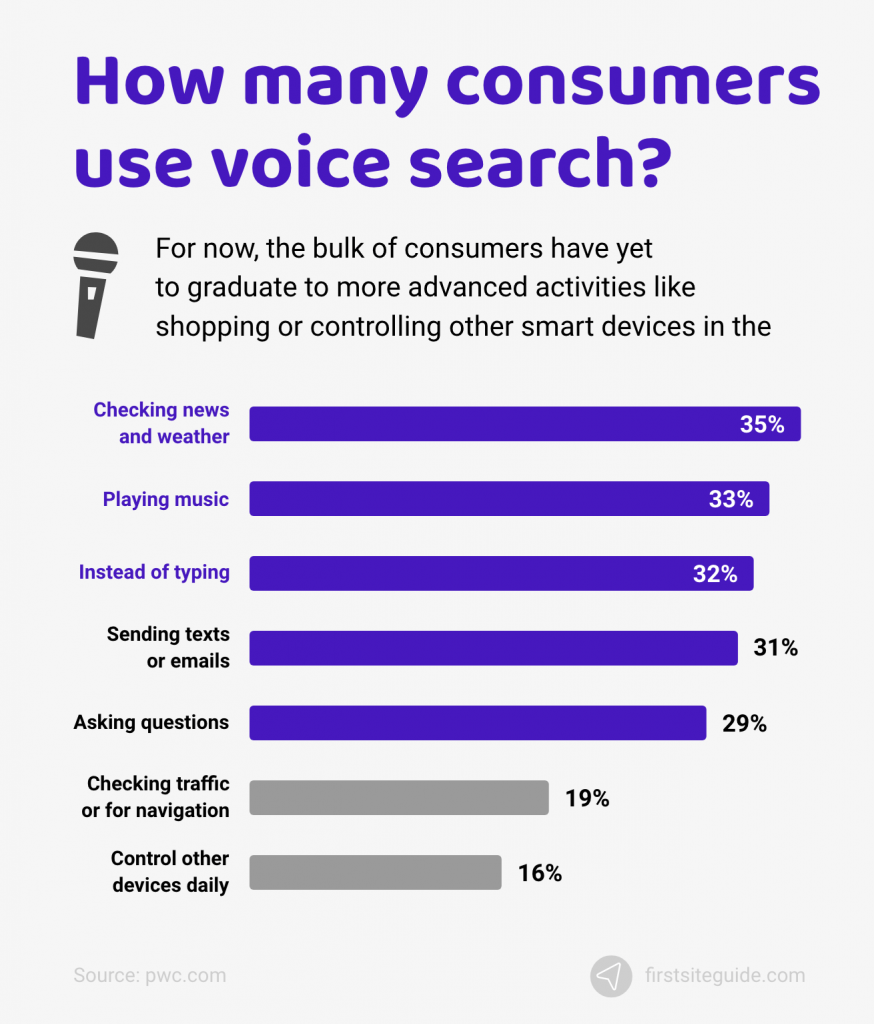
What Is Voice Search & How to Optimize for SEO
The Voice Search function on mobile eliminates the need to type in a search query. So, digital marketers should know how to optimize or create content for Voice Search SEO.
As technology advances, voice searches will increase, so businesses must optimize their website content to align with them. Voice-based searches have become increasingly popular due to the following:
- Reliability and accuracy of voice recognition technology;
- Its convenience and ease of use;
- The popularity of voice-enabled devices like smart speakers;
- A growing preference for natural, conversational interactions with technology.
Why are Voice Searches Popular?
Voice Search is a hands-free way of looking up information on the Internet.
It significantly differs from text-based search because users speak their queries or commands to their devices or voice assistants. Afterward, the assistant or device converts spoken queries into text. Then, search engines can process the converted query.
Because there’s no need to type them out, voice queries allow for more natural language. Users tend to speak in complete sentences, so you must consider conversational queries when optimizing for Voice Search.

Source: FirstSiteGuide.com.
People use Voice Search for various reasons, including checking the weather, playing music, or as an alternative to typing. Also, people look to voice-enabled devices to get their news. So, optimizing for voice queries using SEO is vital to various businesses, including news websites.
How Does It Work?
Voice assistants utilize powerful computing systems and cloud-based resources and data. This allows them to enhance their ability to accurately recognize speech, understand language, and generate responses. As a result, they can provide users with more precise and personalized responses.
There may be differences in the technologies and algorithms used by voice assistants or Voice Search-enabled devices. But, most systems share the fundamental principles of speech recognition, Natural Language Processing or NLP, and response generation.
Here’s a quick rundown of how Voice Search works:
- First, users activate or voice-enabled device or a Google Assistant with a trigger word or a physical button.
- The user will then speak their query. Then, the device will use Automatic Speech Recognition or ASR technology to convert the spoken query into text.
- Next, the assistant or device will extract meaning and intent from the transcribed query with NLP.
- Once the assistant or device accurately understands the query, search engines process it to find matches on the Internet.
- After relevant information is retrieved, a response is generated.
- Finally, the device speaks the response aloud to the user with Text-To-Speech or TTS technology.
SEO for Voice Search and Its Importance
Voice assistants rely on powerful computing systems, cloud-based resources, and data to improve accuracy. So, SEO has a significant impact on Voice Search. High rankings on Search Engine Results Pages mean your content can be the chosen answer for a voice query.
Currently, 71% of consumers prefer to use voice searches to find information, according to Oberlo. So, you must optimize your website and its content to improve visibility.
Differences Between Voice Search and Traditional Search
Search Query Length and Complexity
Voice-related queries are typically longer and more conversational than text-based ones. After all, people tend to use natural language and complete sentences when speaking to their voice assistant.
Meanwhile, text-based searches are usually a few keywords or -phrases long.
User or Searcher Intent
Voice Search queries often express more explicit user intent compared to text-based ones. People use it to ask direct questions or provide ample context. However, text-based searches are more ambiguous than their audio counterparts.
Search Results Format
Search engines will display text-based results on a device screen. The voice assistant or device verbally delivers the most relevant search result.
Thus, the search feature immediately provides concise answers or limited options. It allows users to scan through multiple results, click on links, and explore further.
Emphasis on Local Search
Voice Search has a strong emphasis on local search. Users frequently ask for directions, nearby businesses, or recommendations.
Voice assistants often provide location-based results to cater to these queries. Thus, you need to learn about the quick, easy tips to elevate your local SEO. You should think of ways on how to effectively optimize on local search for targeting voice assistants or voice-enabled device users.
Creating Featured Snippets
Voice Search often relies on Featured Snippets that directly answer user queries. Text-based searches will show a Featured Snippet in standard search results pages.
Then, voice assistants read the snippets aloud, giving users immediate information without needing to click on specific results. Thus, optimizing content using SEO to create a Featured Snippet can improve visibility for people who search with voice queries.
To make your content more visible, SEO specialists should consider these differences. Then, they can optimize a business’ online presence accordingly.
How to Optimize for Voice Search
Voice-based searches can help you stay ahead of the competition by boosting your content’s visibility. Here are some considerations when using SEO to optimize or create content for Voice Search:
Use Long-Tail, Conversational Keywords
Like with all SEO efforts, keywords are critical for Voice Search. SEO specialists must conduct keyword research for relevant queries, which are longer and more conversational than text-based ones.
Anticipating conversational phrases for voice searches is a crucial SEO trend. So, businesses must incorporate long-tail and question keywords into website content.
Also, you must structure your content to answer questions people will ask using conversational queries.
Focus on Searcher or User Intent
You can find the best voice-related keywords by focusing on user intent. After all, you must align your content and website structure with the way people speak and search.
By doing so, you can better cater to user needs and preferences.
Focus on Creating Featured Snippets or Reaching Position Zero
By optimizing your content to appear as a Featured Snippet, you increase the chances of being a voice assistant’s response.
Thus, SEO specialists must ensure their content structure is concise and relevant. This can help your website provide direct, comprehensive answers to commonly asked questions through the right question-based keywords.
As a result, you can ensure your content appears in position zero on SERPs.
Make Your Website Mobile-Friendly
According to latest voice search statistics, in a survey, 57% of respondents issued commands to their smartphones rather than laptops, speakers, and TV remotes. So, businesses must ensure their websites are mobile-friendly.
So, you must optimize for mobile, making your website adaptive and responsive. In addition, you must keep your business page load speed under three seconds. It’s critical to provide a seamless user experience on smartphones and other mobile devices.
Optimize Your Site for Local SEO
Many voice searches are location-specific, so optimizing for local SEO is crucial for better visibility. Thus, you should optimize your website content using location-based queries.
Optimizing your Google Business listing is also worth doing for better visibility.
Implement Structured Data Markup
Structured data can improve your SERP standing for voice queries. Implementing crucial structured data formats will make your content more visible to Voice Search results.
Regularly Monitor Your Analytics
Of course, monitoring and analyzing data is crucial for refining SEO strategies. So, it’s vital to use the proper analytics tools and platforms to collect data relevant inquiries.
Keeping track of your analytics can help you evaluate the effectiveness of your optimization methods.
Final Thoughts
Voice Search uses advanced technologies like Automatic Speech Recognition and Natural Language Processing to comprehend and process spoken queries.
There are critical differences between voice- and text-based search, such as:
- Search query length;
- User intent;
- Search results format;
- Emphasis on local search; and
- Featured Snippets.
Thus, businesses must optimize their website content for Voice Search. All in all, businesses need to adapt their SEO strategies by focusing on the following:
- Keyword research for conversational keywords that focus on user intent;
- Creating Featured Snippets to reach position zero on SERPs;
- Mobile optimization for your website;
- Optimize your site for Local SEO, including your Google Business profile;
- Use structured data markup; and
- Monitor your SEO analytics for future improvement.



















Comment 0